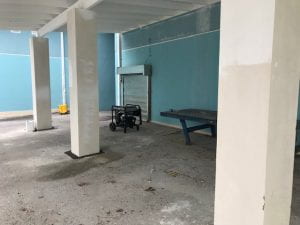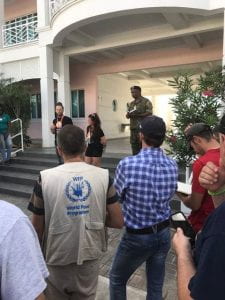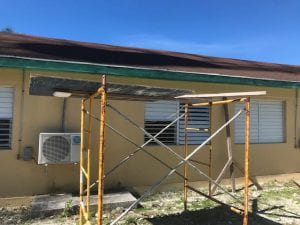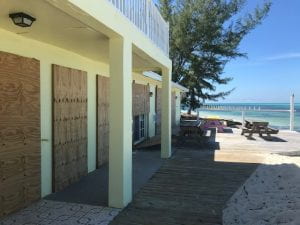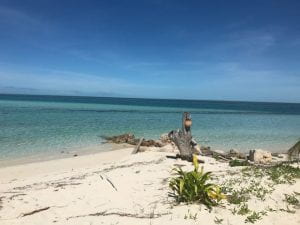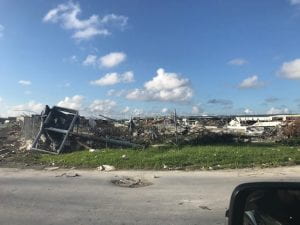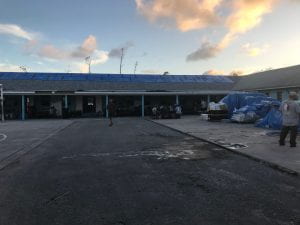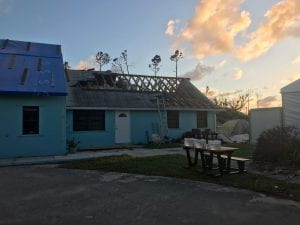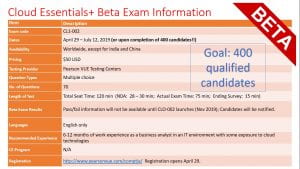Thankfully Southwest Airlines provides Internet access for a fee. Leaving San Diego at noon today, I’m flying through Nashville to Ft. Lauderdale today, spending the night there and catching flights, first to Nassau, and then on to Great Abaco. The relief effort I’ll be involved in is detailed in the Information Technology Disaster Resource Center’s LinkedIn site, and is worth taking a look at to see photos and other information relating to the status of the disaster recovery efforts. I’ll be there for a week, heading back home on Saturday, October 26th. I’ll be detailing on this blog site my experiences over the week, but first wanted to explain how I became involved with the ITDRC and what it took to participate in this deployment. My purpose in doing this is to see if what I write provides an interest in participating.
I was introduced to ITDRC by Alysia Stark, a student who signed up for Coastline Community College’s cybersecurity apprenticeship program. Based on my review of the ITDRC website, I joined the organization in January 2018, with the thought of eventually completing their requirements associated with actual deployment. Those requirements identified below are classes that can be completed online:
- ITDRC-100 (available through the member portal)
- FEMA IS-100
- FEMA IS-700
Having recently completed those courses, I qualified for deployment. In order to bolster my chances of being deployed, I took the following two online classes that are required to qualify for the Critical Information Systems (CIS) Team:
Based on my learning experiences for the four (4) completed FEMA classes, my intention is to take an additional class the ITDRC leadership recommends. It is not online, so I’ve registered to take the IS-300 course in San Diego in late January.
While I’d like to think that my classwork detailed above along with my academic qualifications and industry-recognized certifications resulted in my being selected for deployment, I’m reasonably sure the recent article I authored for Certification Magazine helped in the decision process. Titled “ITDRC volunteers enhance their IT skills through disaster recovery assistance,” the article details key benefits that might accrue for professionals and students who volunteer for projects the ITDRC is involved in.
I first learned of the deployment on Tuesday, spending Wednesday and Thursday packing for the adventure. Thankfully, based upon Internet research, the ITDRC Slack Channel, and advise provided through email, I was able to prepare what to carry with me in terms of what I’ll be wearing and creature comforts. I’m sure I’ll be providing my own advice in subsequent postings to this blog. What I can tell you is I have absolutely no expectations that this next week will be anything that resembles a “vacation.” That’s enough information for today.
DAY 2 – October 19, 2019
I managed to get a good night’s sleep in Fort Lauderdale (FLL), which will likely be my last for a while. After a quick comfortable shower (again likely my last for a while), the day started with me flying from FLL to Nassau (NAS) and a quick 25-minute flight from there to Marsh Harbour (MHH).
Made it to MHH around 3:30p.m. local time. The photo below shows the generator provided by the ITDRC to run the airport terminal.
I spent the remainder of the day getting familiar with the living arrangements. We are housed in what was a Christian church and school that was heavily damaged as the result of the hurricane. The interior walls have the sheetrock removed, and the roof is covered with a tarp. In the morning I’ll survey the site and hopefully provide an update with pictures.
DAY 3 – October 20, 2019
Early morning start (5:30a.m.) as the movement around the camp started to increase. Thankfully, coffee is available.
Today’s focus was primarily dealing with the needs of law enforcement and military operations. The Royal Bahama Defence Force has two sites, one at the airport and one at the port. The airport effort involved putting in a new Internet access point and getting the second access point configured so it provides Internet access. We also went by the police headquarters, but it is Sunday and it was closed. The picture below shows two police boats that are no longer seaworthy. All in all a good, but exhausting day.
DAY 4 – October 21, 2019
Today’s focus was to first attend the Island briefing at the Abaco Governmental Center. Briefings are held on Monday, Wednesday, and Friday. The pictures below are from the general briefing and there was a follow-up briefing with the Abaco Superintendent of Education.
That meeting was follow-up with a trip to the local hospital. ITDRC placed two Internet access points in the hospital. Fortunately, it looks as though they are finally scheduled to get access to the Internet from their “pre-disaster” source and we will be pulling those units out today. The picture below shows the current power source serving the hospital.
The evening meals here are provided by World Central Kitchen. For lunch, the choice is generally “Meals Ready to Eat (MREs).”
DAY 5 – October 22, 2019
The wake up had me feeling a bit tired, with a sore back likely due to sleeping on a cot without an air mattress. Good news is Chris and Debbie leave today. It’s good news because when Chris exits his cot, I’m moving in to take advantage of the air mattress. Bad news is I’ll miss their support and ITDRC leadership. The day was spent, first with a drive to the South end of the Island and Sandy Point School. In a creative fashion we managed to extend the coverage of existing wireless beyond the single pre-school classroom to a number of other classrooms through the placement of additional access points (one in a middle classroom, where the existing access point wasn’t connected to the service the ITDRC was providing), and the Rube Goldberg mounting structure we put together with the basketball backboard and a scaffold (see pictures below).
While at “Sandy Point,” thought it a good idea to see what the beach looked like. Below are pictures of the beach, along with a very nice home that continues to be boarded up, some seven (7) weeks after the hurricane. They have had looting issues, so that maybe the issue, with the plywood remaining until the owner returns.
The next project involved that took much of the afternoon was installing a new antenna for radio use at the island’s power plant. Fortunately, I was simply an observer, not having to go airborne in the bucket truck’s bucket.
DAY 6 – October 23, 2019
This was actually a fun day. It started with the morning briefing at the Government Office. Our plan after the meeting was to see if we could get to Green Turtle Cay, to look to see if we could fix the Internet access at the school. While there we met a person from IDEA, a relatively new non-profit created after the hurricane that had the goal of transporting people and resources around the Bahamas. Fortunately, they were going to do a round trip to Green Turtle Cay that morning and agreed to allow us to ride with them. What a great ride, the pictures illustrate why we enjoyed the trip, that included a brief swim (a reasonable substitute for a much-needed bath), when we arrived next to the “Fat Shirley” their luxury boat. We managed to get the Internet up and running, enjoying the day’s experience while doing some good for the school.
DAY 7 – October 24, 2019
To suggest that today was challenging would be an understatement. The day started waiting in line to get another Internet modem. Unfortunately, the window at the service provider wasn’t open so we took a short time viewing the destruction around March Harbour. A few of the pictures, showing this destruction are shown below.
Our second stop after obtaining what we needed from the Internet provider was at the Government Office to install Internet access for the head of the Bahamas National Emergency Management Agency (NEMA). After completing that project we headed North to Cooperstown to complete the school project that we had surveyed earlier in the week. That was certainly an exhausting and lengthy effort, arriving back at camp too late to eat the hot meal. So we suffered through one more MRE that certainly wasn’t the best spaghetti I’ve had. Something is certainly better than nothing, which is what I suspect some of the residents of Abaco had this evening.
DAY 8 – October 25, 2019
Started this morning with an early arrival at the Government Center to see if we could get the Internet satellite system up and running. No success. It is probably a wiring issue and we are not equipped to deal with it. In walking around the Center I noticed on the front glass door of the Magistrate Court #1 the calendar for the time period from August 25-29. Rather telling, given the hurricane hit Abaco on September 1st.
After the scheduled morning briefing our plans had us heading South, eventually to Sandy Point to check on that installation and do a little clean-up that includes a more permanent mounting for the access point we installed earlier in the week. The morning briefing included the opportunity to meet and both give and receive “thank you messages” from both government officials and from the other non-governmental organizations (NGOs) we worked closely with over this past week and the 8 weeks after the hurricane. Then it was off to Cherokee Sound and Crossing Rocks, two schools that had wireless systems installed by earlier teams. Both sites reported challenges but that was likely the result with the ISP provider and would be followed up remotely. We lacked sufficient time to travel down Sandy Point, and instead returned to Marsh Harbour. providing an opportunity to both view the damage and take pictures that are shown in the “reflections” below, and enabled us to solve the Internet access problems the Abaco police were having at the Government Center. All in all, it was a lighter day and one that allowed us to decompress a bit relative to what we had been doing during the previous days. After returning to the camp, our home while here on Abaco, I took a few pictures that show our accommodations.
The sleeping area, along with my lovely “cot,” are shown in the pictures below.
As noted in a daily report above, we had access to Meals Ready to Eat (MREs) along with a hot dinner meal that was provided by World Central Kitchen. However, there were days when we arrived back to camp too late for dinner. I will give credit to WCK, as they were providing somewhere around 8,000 meals a day. The photo below shows my final dinner and is representative of a typical meal consisting of hamburger meat, rice, and some vegetables. Note also the small package of pringles.
DAY 9 – October 26, 2019
I’m beginning this post early because I suspect I won’t have time to do it effectively as I travel to the Marsh Harbour Airport for a 9:45a.m. departure. There will be a lengthy layover in Nassau (4 hours), but the good news is I will clear U.S. Customs in Nassau rather than waiting until I arrive in Ft. Lauderdale. That is good since my layover there is only a little over an hour before departing home to San Diego, via Denver.
Reflections
The flight home went as expected with some challenges in Nassau where our baggage was loaded and shortly before the plane was ready to back out of the gate we were informed that the baggage had to be unloaded and processed through the x-ray machine again. That delay resulted in a one-hour late arrival in Nassau. Fortunately, I had a planned four hour stop in Ft. Lauderdale, so it simply resulted in my spending less time at that airport. I thought about writing my reflections during the flight home, but truthfully I was simply too exhausted to complete the effort.
What I can tell you is the experience was well worth the effort. Given the opportunity to help people by providing access to the Internet resulted in so many people thanking us. Think about how you would feel being cut off from the world for two months with no idea what is going on. A comment by a hospital administrator provides insight. He said that making the Internet available to visiting healthcare providers resulted in their willingness to stay on Abaco for longer periods of time. During their off-hours it gave them something to do, enabling them to reach out to family and friends, and hear what was happening in their world.
My plans relative to this experience are to share what I went through with faculty and students in the California community college world. I will be championing the idea of joining the ITDRC, providing opportunities to volunteer. Given the challenges here in California with wildfires, there will likely be a need for ITDRC involvement, just like it did for the Camp Fire in Butte County. I’ve created a folder containing some of the pictures I took while at Abaco. I’ll add more pictures as I receive them from fellow ITDRC volunteers. You can access the folder by clicking HERE.
If interested in volunteering with the ITDRC, you can access the member application site. If you have other non-IT interests in terms of volunteering, I’d recommend Team Rubicon. They served as our host, with the primary function of helping residents “muck” out their homes and covering the roofs with tarps.
If you have any questions, don’t hesitate in reaching out to me at linthicum_steve@rsccd.edu.

